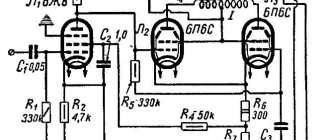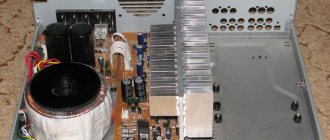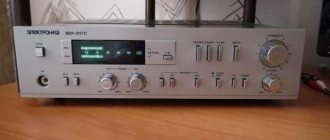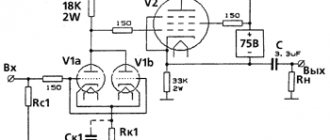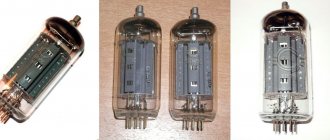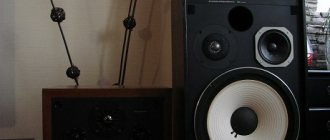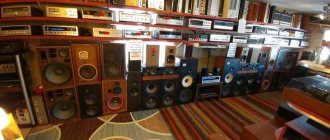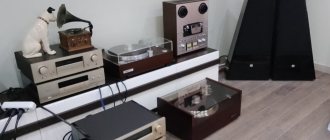When talking about the main charismatics of audio, it is impossible to ignore McIntosh Laboratory - a 100% American product, like Coca-Cola or Cadillac. Almost 70 years have passed since its founding, and there is every reason to believe that McIntosh's black glass panels and blue backlit dial indicators have been canonized by audiophiles around the world.
The history of McIntosh Laboratory began in 1949 in Silver Spring (Maryland), and its organizer was engineer Frank McIntosh. In 1942, Frank had a small consulting business in Washington, DC, developing radio stations, TV stations, and sound systems. To operate, Mackintosh needed a powerful, high-quality audio amplifier with a minimum of distortion, but none of the samples produced at that time were suitable for him. Being a perfectionist by nature, Frank decided to assemble such a device himself.
Years, engineers, amps
In 1946, he hired experienced designer Gordon Gow as an assistant. Introduced three years later, the 50W-1 tube model featured the Unity Coupled Circuit, which was subsequently patented and is still used in some of the company's amplifiers, providing high power and clear sound. The monophonic 50-watt device provided a frequency range from 20 to 20,000 Hz and had a distortion coefficient of no more than 1%. After a successful start, Frank and Gordon continued development. So, in 1950, the first tube preamplifier AE-2 was released, and three years later - the A116 tube amplifier. Next in the line is another preamplifier, the C108.
In 1951, Sidney Corderman joined the company to head the engineering department for research and development and remained in this position for 40 years. Corderman managed to make McIntosh a leader among Hi-Fi equipment manufacturers. Production planning, purchasing and finance were handled by Maurice Painchaud, now known as McIntosh's "silent hero". In the 50s, the company moved to Binghamton (New York), where it remains to this day, despite belonging to the Italian holding Fine Sounds SpA. At the same time, the company acquired its first MR55 tuner and C20 stereo preamplifier.
McIntosh C20 Stereo Preamplifier
In 1962, experienced engineer Dave O'Brien became head of McIntosh's amplifier development department, and the MX110 tuner-preamplifier with a Panloc system, which allows the chassis of the device to be pulled out of the case, appeared in the line. In 1963, the company released its first integrated device, the MA230, with an all-glass front panel. A year later, the first transistor preamplifier C24 was released, and in 1965 another first-born appeared - the McIntosh MAC1500 receiver.
In 1967, the company decided to get into speakers. In the same year, the line was replenished with the MC2505 transistor power supply. The model carried characteristic features that have been preserved in McIntosh amplifiers to this day: a glass front panel, blue-illuminated power indicators, a Sentry Monitor circuit to protect the output transistors, and autotransformers.
In general, it was in the 60s that the McIntosh company finally acquired cult status. The dubbing of the concert stage of that very Woodstock was performed on the “Poppy” blocks. In those years, sound engineers were just getting a taste of the Wall of Sound concept, and The Grateful Dead embodied it literally at their concerts - in the form of a multi-ton wall with a battery of speakers and McIntosh MC2300 amplifiers (48 pieces, 2 x 300 W), giving a total of 28,800 W.
"Wall of Sound" construction diagram for The Grateful Dead concerts
There was no separate bank of monitors for the musicians—"they played right in front of this sound system instead of being away from it," says Charles Randall, the company's current president. “So they had a chance to experience and hear everything that the staff heard.” 28,000 watts was a huge amount of power for that time.”
In 1977, Frank resigned, and Gordon Gow took over as president. In 1979, McIntosh added an impressively sized anechoic chamber for speaker testing. Some of the most iconic amplifiers in the brand's history also include the MC2500 500-watt transistor stereo power amplifier (1980), the MC2600 (2 x 600 W) and the MC7300 (2 x 300 W) amplifiers (90s).
Stereo amplifier McIntosh MC2500
McIntosh components, especially tube amplifiers, have always been highly regarded by audio enthusiasts in Japan. It is therefore not surprising that after the death of Frank McIntosh in 1990, the company was bought by Car Audio by Clarion. During this period, the brand expanded its influence into car audio and home theaters. In 2003, the brand was acquired by the D&M Holdings corporation, which also brought together Marantz and Denon under one roof, and in October 2012, McIntosh came under the wing of the Fine Sounds SpA holding.
Despite globalization, the company has long avoided deliberate publicity and PR campaigns aimed at short-term benefits. When asked by reporters about moving production to other countries, company president Charles Randall confidently replied: “As long as I’m at the helm, you will never see our components manufactured entirely or assembled from off-the-shelf parts abroad.” Randall spoke about the correct sound transmission and the company’s credo: “There is only one musical material, the sound of which is determined by the artist who created it. Our job is to not interfere with this and convey everything as it is.” This year was no exception. McIntosh quietly announced several new products at CES. All of them are made according to the company's traditions of engineering and design, but are equipped as if they were only supposed to be released a couple of years later.
CONCLUSION
MC611s may be very expensive, but they are impressive for their price.
Most surprising is their rich sound, embellished with silky smooth high speed but with an incredible amount of internal detail. This was done for a beautiful organic presentation, supported by wide dynamic contrasts. They are just great!
Rice. 3. Frequency range of McIntosh MC611
Rice. 4. Harmonic distortion
McIntosh MX160 Multi-Channel AV Processor
The new McIntosh MX160 AV processor is the brains of your home theater experience, as evidenced by its support for the latest Dolby Atmos and Auro-3D surround sound codecs. The effective RoomPerfect system helps you precisely adjust the sound of your speakers to a specific room. To do this, the calibration microphone is connected to a separate balanced input.
McIntosh MX160 AV processor
The model has a classic glass facade, illuminated by fiber optics and LED diodes and equipped with functional buttons and handles. In its center is a 2-line display, and below it are illuminated symbols and names indicating the type of signal used at the input, as well as which of the multi-channel formats is supplied to the input and which is present at the output (each of the 9 characters for input and output corresponds to a specific channel).
The AV processor works with the 4K input signal or upscales any video to this resolution. To achieve this, the MX160 is equipped with eight HDMI inputs and four latest generation HDMI outputs with HDCP 2.2 support. HDBaseT technology is supported (there is a corresponding output) for transmitting an uncompressed high-resolution AV signal over a distance of up to 100 meters without loss of quality.
McIntosh MX160 AV processor, patch panel
There are 16 XLR output connectors that can be used to create an 11.1-channel connection (or 7.1.4-channel for Dolby Atmos), with an additional 4 used for bi-amping or subwoofers. The model has the following digital inputs: three coaxial and four optical, balanced AES/EBU, two regular USB and one asynchronous USB (24 bit/192 kHz). Analogue inputs: two balanced XLRs, 4 RCAs, MM phono input and 7.1 channel RCA. To connect to the local network, two corresponding sockets are used; there are coaxial and linear outputs for the second zone. It is possible to adjust the volume level for each input, as well as rename analog and digital connections.
The processor weighs more than 14 kg, has a harmonic coefficient of no more than 0.005% and allows you to build a DC system of the highest level.
SACD/CD transport McIntosh MCT450
The MCT450 transport, first presented at CES 2015 in Las Vegas, is stylistically fully consistent with the corporate concept, as it has a polished steel chassis and a black glass front panel with aluminum side inserts and characteristic lighting. In the center of the panel is a die-cast aluminum tray for a high-precision dual-laser SACD/CD drive. Below it there is a small display, to the left and right of which there are functional buttons for controlling playback, selecting a hybrid SACD layer, power supply/standby, opening the tray and selecting the track time display mode. Reading speed has been increased by 2 times for more accurate work with CDs. The power supply uses an R-Core transformer and a number of stabilized power supplies.
SACD/CD transport McIntosh MCT450
The McIntosh MCT450 transport features a full range of digital outputs, including coaxial (PCM, up to 24-bit/96 kHz), optical (PCM, up to 24-bit/192 kHz) and balanced AES/EBU (PCM, up to 24-bit/192 kHz or up to 32 bit/96 kHz). A special digital DIN connector is used to output the DSD signal taken from SACD (two-channel or multi-channel). According to McIntosh, this output provides the clearest sound. A similar DIN connector is available on board preamplifiers such as the C52, C47 and D150, with which it is preferable to connect this transport.
McIntosh MCT450 SACD/CD transport, rear view
The model weighs almost 12 kg and, thanks to its exceptionally accurate digital signal reading and transmission, is quite capable of bringing to life a collection consisting of SACD and CD. To control the McIntosh MCT450, a remote control with illuminated buttons is provided.
SOUND QUALITY
The MC611s were connected to a Martin Logan ESL-X speaker system via Chord Signature Reference cables. The signal source was an Oppo UDP-205D Blue-ray player connected to the XLR input to play both CDs and connect the Astell & Kern AK120 portable player. The sound was so intriguing that I also, as an alternative, connected my music library through the Icon Audio PS3, which, like the Oppo, has a volume control so it can be used directly without an intermediate preamp. We also used a Timestep Evo modified Technics SL-1210 Mk2 turntable with an SME309 holder and an Ortofon Cadenza Bronze pickup.
Playing high dynamic range CDs has shown some exciting properties. The MC611 sounded supremely smooth and silky in the highs and mids—reminding me of the Icon Audio Stereo 30SE tube amp.
They also have quite a rich quality - again, like tube amps. But then there was dynamics: sudden fluctuations from a very calm background to fast beats, such as at the beginning of Safri Duo's "Sam Adagio", where the rapid rustle that started the track came out of the "speakers" before the droning synth bass kicked in with full force .
The "quick rustle" was unusually sweet and tinsel, like other transistor amplifiers have a peculiar quality.
Likewise, Nils Lofgren's guitar strings on "Keith Don't Go" were bright but not the stripped-down stuff I'm used to, possessing more visceral detail and an ornate analogue feel that was nice to hear.
This feeling of uncluttered ease was more surprising than the MC611's dynamics. I was expecting an extreme listening experience, like muscle amplifiers, but instead I heard something completely different: a laid-back yet complex sound that was effortless but convincingly real.
The soundstage was solidly constructed, and there was a good sense of depth, a gentle aura surrounding the Chicago Symphony Orchestra playing Mahler's Symphony No. 8, Veniar Creator Spiritus (24/96), without compromise with dynamics that were strong.
According to McIntosh, their use of bisymmetrical circuits subjectively cancels noise and distortion to reveal an almost eerie silence from these amplifiers between musical crescendos. There's certainly supreme bass grip and pull, with plenty of timbral expression in John McVie's bass on Fleetwood Mac's Dreams, (24/96).
LP sounded as easy as CD and Hi-Res. There was less contrast between the Icon Audio PS3 and Oppo UDP-205D than I expected, but the LP - as always - had a sense of speed and liveliness that carried over strongly to the 611.
McIntosh D150 Preamp/DAC
The McIntosh D150 model is a digital preamplifier with a DAC on board, which differs from its counterparts primarily in its small body height (9.8 cm), although it has characteristic “family” design features. A 6.3 mm headphone amplifier output with an impedance from 20 to 600 Ohms is located on the façade, and a single-line FL display with adjustable brightness is built into the center. On the left is a selector with electronic logic for accurate switching between inputs, on the right is a precision volume control in 0.5 dB steps. On the front panel there is a Mute button, a power/standby key and a setup menu button.
McIntosh D150 Preamp/DAC
The on-board 8-channel digital-to-analogue converter ES9016 SABER 32 Ultra DAC, borrowed from the D100 model, is used in an effective Quad Balanced mode. Therefore, music at all levels is reproduced with extreme precision. Via an asynchronous USB input, the DAC works with signals in 32-bit/384 kHz resolution, as well as DSD64, DSD128 and DXD formats with sampling rates of 352.8 and 384 kHz. In addition, the model received two coaxial and optical inputs that accept signals at 24-bit/192 kHz resolution, and a DIN digital input connector for the purest sound possible, which supports PCM and DSD formats. The rear panel of the McIntosh D150 also has fixed line outputs RCA, XLR and duplicating adjustable outputs.
McIntosh D150 Preamp/DAC, Patch Panel
The preamplifier can be connected via bus to other proprietary components. The DATA mini-jack connection allows it to be controlled by the remote control of other devices, such as a McIntosh AV processor. The device has a low-noise R-Core transformer in the power supply, has an exceptionally low harmonic distortion coefficient of 0.0015% and guarantees extremely accurate and transparent sound. The kit includes a universal remote control.
McIntosh MHA100 Headphone Amplifier
The device is the first headphone amplifier in the company's lineup and uses a specially adapted version of the company's autotransformer technology in its design. The appearance of the MHA100 follows the McIntosh design school, has blue-backlit dial indicators and a modern 2-line OLED display. A mini remote control is included.
McIntosh MHA100 Headphone Amplifier
Thanks to two autotransformers, it is possible to perfectly match the characteristics of the McIntosh MHA100 with the impedance of the headphones, which ensures reliable operation of the amplifier with three load ranges: 8-40 Ohms, 40-150 Ohms and 150-600 Ohms. In this case, you can choose one of two operating modes for each range: with an output power of 1 W or 250 mW. The result is superior sound quality, both with earbuds and full-size stereo phones.
Headphone Crossfeed Director (HXD) technology allows you to achieve a large-scale sound stage with excellent localization of musical images, characteristic of conventional speakers. The model also has a built-in 5-step bass booster with 2.5 dB steps.
McIntosh MHA100 headphone amplifier, rear view
The amplifier features an efficient McIntosh Digital Engine differential DAC and a full complement of digital inputs, including balanced, optical, 24-bit/192 kHz coaxial, and 32-bit/192 kHz USB asynchronous. The signal is upsampled to 32 bit/192 kHz before being sent to the DAC. The model has analog inputs (RCA and XLR), system bus connectors and Pre Out for a speaker or subwoofer.
The compact dimensions of the 12-kilogram case allow the MHA100 to be placed on a table, and the presence of two pairs of gold-plated output terminals turns it into a full-fledged 50-watt amplifier for 8-ohm speaker systems.
McIntosh MHA100 Headphone Amplifier and McIntosh MHP1000 Headphones
Low-noise ThermalTrak transistors with temperature control are installed at the output, and the Power Guard system is used for overload protection. A large power transformer is installed in the power supply unit. Stabilized power supplies help minimize distortion.
“The MHA100 is for those purists who do not accept any compromises in sound,” states Hi-Fi News. And on the well-known Internet resource CNET this device is called the “Cadillac” of headphone amplifiers.
McIntosh - Handmade Products
McIntosh is a high-tech hand-built product.
The American company McIntosh was founded in 1949 and celebrated its 60th anniversary in 2009. The company is named after its first president and creator Frank Mackintosh, and has nothing to do with the popular Apple computer brand.
1990 - The Japanese company Clarion acquires the prestigious American
The Japanese company Clarion was founded in 1940 under the name “Hakusan Wireless Electric”. In 1947, the name Clarion was officially recorded. According to the company, the original meaning of this word is “clear and bright sound.” Clarion, a Japanese manufacturer of automotive audio and video equipment, entered the market in 1940. The company was the first in Japan to begin producing car audio equipment. In 1959, it released the world's first transistor radio, and soon - in 1963 - the CA802 stereo car radio and component speakers. Keeping up with the times, the company was the first to introduce a digital car radio in DAT format. In 1990, Clarion began collaborating with McIntosh , becoming a well-known manufacturer of Hi-End equipment. The company appeared on the Russian market in 1995.
McIntosh Laboratory is a manufacturer of high-end audio equipment. The company is located in Binghamton, New York, USA. McIntosh was founded to produce the highest quality audio components. McIntosh Laboratory was born at the dawn of the first high-quality audio systems. The founder of the company and his colleagues established a high level of sound reproduction quality in music and cinema systems for the home, thanks to the manual assembly of equipment in their own factory, as well as a large number of their own developments and new technical solutions.
Currently, McIntosh Laboratory has more than 35 patents.
McIntosh Corporation began its work in the late 40s. Frank McIntosh owned a company in Washington, D.C., that consulted and developed radio and TV stations. To work, a powerful amplifier with a low distortion level was needed, which the market could not offer at the moment. He decided to create an audio amplifier that not only met the specifics of his work, but also exceeded industry standards. To further advance his idea, Mr. Mackintosh hired Gordon Gow as a technical consultant in 1946. Together they set about developing an amplifier that produced great sound and set the standard for the entire audio industry to this day.
Frank McIntosh Gordon Gow
McIntosh Laboratory Corporation was incorporated in 1949 with Frank McIntosh at the helm and Gordon Gough as vice president. Soon they were joined by Cidney Codermari, heading the technical and research department. In the 1950s, in the post-war economy, it was the television and radio broadcasting business that helped McIntosh get on its feet.
McIntosh's first production. Many feared that the floor would not support the weight of the equipment.
The company soon moved into the hi-fi market. In 1950, Gordon Gow became CEO and the company released its first preamplifier, the AE-1. In 1953, the company introduced the A 116 power amplifier and the C 108 preamplifier, and the following year the MC30 amplifier and the C4 preamplifier. The development of production required more space, and the company moved to Chambers Street, Binghamton, New-York. Meanwhile, the company wasted no time and in 1957 introduced its first AM/FM tuner, the MR55.
Preamplifier AE-1 Amplifier A-116 Preamplifier S-108
The MS-30 amplifier and the S-4 preamplifier are a wonderful pair of components from the middle of the last century!
The 1960s were marked by innovations, including the invention of McIntosh's famous illuminated front panel. The story goes that the front panel design was suggested by Gordon Gow, and after inventing his own ink, McIntosh's signature gold lettering appeared, which glowed in the dark. The first product with an all-glass panel was the MI-2 tuning indicator.
The first McIntosh product to feature a proprietary glass panel.
In 1967, the acoustic systems development department was created. The main products of this decade were: the first stereo amplifier MC240, the first tuner-preamplifier with the Panloc MX software tuning system, MR67 and MR71 tuners, the first transistor product - the C24 preamplifier, the first transistor amplifiers MC250 and MC2505 and MC2105; the first transistor tuner-preamplifier MX112 and the first McIntosh receiver - MAC 1500. The Woodstock music festival in 1969 summed up this decade. McIntosh amplifiers were used at this festival.
Amplifier MS-240 Preamplifier S-24 Receiver MAS-1500
Tube amplifier assembly shop. The world's first conveyor belt High-End!
The 1970s saw the release of the first McIntosh acoustic models - ML1, ML2, ML4. The McIntosh MR78 tuner, which was released in 1972, remains an all-time classic to this day. That same year, McIntosh received a patent for electronic circuit designs. The company also receives patents for its speakers, equalizer and Power Guard system. In 1977, Frank Mackintosh resigns, and the great engineer Gordon Gow himself takes the place of president.
Speaker system ML-4 Tuner MR-78
In 1980, a full-size anechoic chamber was built in the company's acoustics department, which was involved in testing the equipment. And the first product to successfully pass such testing was the XR16. McIntosh continued to receive patents in the 1980s. The MC2500 and XRT20 power amplifiers received patents and were released in 1980. In 1985, McIntosh's first CD player, the MCD7000, was introduced. At the same time, McIntosh released the XRT18, the first speaker designed using a computer.
in June 1989 . The company's management decided to merge with the American branch of the Japanese company Clarion.
Frank McIntosh died in 1990 at the age of 83 . And the McIntosh company is completely bought out by Clarion, which expands the McIntosh business and brings it to the car audio market. In 1994, McIntosh released its first car speaker. The '90s also saw several innovations, including: the first built-in speaker, the WS200; XR290 - speaker system with the first system of 4 woofers; MF and HF speakers and LP/HP technology. The C 39 preamplifier, MC7106 power amplifier and NT series speakers had a certified McIntosh THX system. The NT series features three patented rotating tweeters. In honor of the 50th anniversary, McIntosh released a limited edition MC2000 tube amplifier, confirming that interest in classic style is relevant at all times.
In 2000, Clarion decided to expand its business in the field of car audio systems, leading to cooperation with companies such as Harley Davidson, Ford GT and Subaru. In 2001, Charlie Randall became president of McIntosh.
In 2003, D&M Holdings Corporation acquired McIntosh Laboratory. In 2005, in Las Vegas, McIntosh introduced the Reference System line, including the MC2KW monoblock amplifier with a power of 2000W, the XRT2K speaker with a peak power of 6000W; S1000 - preamplifier; CD transport MCD 1000 and D/A converter MDA1000. McIntosh created a new category of video components and offered a complete solution for the indoor cinema with the release of the MDLP1 projector. The end of 2007 was marked by the release of the first turntable from McIntosh - MT10.
The backlit glass panel looks wild on the turntable, but it’s impossible without a corporate identity!
In 2009, McIntosh celebrates its 60th anniversary. In honor of this significant date, McIntosh is releasing an anniversary stereo system. This system is produced in a limited edition (60 sets, especially for Russia) and consists of a C22 preamplifier and a pair of MC75 power amplifiers, as well as a special edition of a book about the history of McIntosh with the autographs of McIntosh President Charles Rendell, designer-developer Sidney Coderman and the author of the book. Ken Kessler. C22 - produced from 1963 to 1972, and then the legendary Frank McIntosh version was produced from 1995 to 1998. Now the C22 returns in an updated version in the company's 60th year of flying. MC75 - the original version was produced from 1961 to 1970. Components with the appearance of the legendary McIntosh models have an absolutely modern design that fully meets the standards of our days.
Updated S-22 preamplifier and a pair of MC75 amplifiers - the cost of the set in Russia is $23,000
The principle of manual and piece assembly, carried out by highly qualified specialists, is still preserved. Over the 60 years of McIntosh's history, almost every employee of this small New York laboratory has contributed to the development of the latest technologies for creating audio devices and electronics. In total, McIntosh employees patented 35 inventions. In addition, McIntosh's reliance on highly trained personnel and hand-crafted manufacturing has always ensured its place among the leaders in audio equipment manufacturing.
The assortment of the McIntosh today is represented not only by power amplifiers, but also by preamplifiers, stereo amplifiers, CD/DVD players, AV receivers and processors, tuners, projectors, and speaker systems (according to the contract, today the acoustics for McIntosh are produced by an otherworldly company). Moreover, along with semiconductor amplifiers, the McIntosh laboratory continues to produce tube amplifiers, which are especially valued by audio connoisseurs.
More information about McIntosh amplifiers.
And so in the late 40s, Frank Mackintosh hired the famous engineer Gordon Gow to develop high-end sound reinforcement equipment. Work continued from 1946 to 1949 and culminated in the release of the 50W-1, followed by the registration of its fundamental principles as invention patents, which effectively marked the beginning of Mcintosh Laboratory Inc. The legendary models were the Mcintosh MC275 and the simpler MC240 and MC225. This title has been earned by some pre-amplifiers and even tuners since the launch of the McIntosh MSZO power amplifier (A-116B platform, the sixth product under this brand since the beginning of the company's history). The model was produced from 1954 to 1962 and at that time was the standard in amplification technology of that time. MSZO was the first truly mass-produced Mcintosh model. The more powerful MC60 (60 W per channel) used a KT88/6550 tube, which is difficult to consider as musical as the classic 6L6 beam tetrodes. The direct successor of the MSZO, the Mcintosh MC40, received the newfangled diode rectification. With the advent of the stereo era, 2-channel tube models began to appear in the lineup. Subsequent models added the number “2” to the index, and it turned out, for example, MC40 and MC75 in the “dual-channel” MC240 and MC275. And only MSZO will forever remain a completely untouched apparatus. Today, ownership of this amplifier is highly desirable for true connoisseurs of the brand and its historical past.
A pair of McIntosh MC-30 monoblocks is not so much of an audiophile value as a collector's value.
We must not forget that the Mcintosh company produced no less legendary models of power amplifiers intended for professional use in recording studios, radio stations, theaters and cinemas.
Explanation - comment: McIntosh company in the world to create a serial assembly of high-end tube amplifiers. This is why, when you disassemble a tube amplifier, you will find circuit boards and connecting cables. The circuit design of the company's tube amplifiers has not changed for many decades, which is not very good. Today, McIntosh exports its products around the world, not only from the USA but also from China, where production is located.
McIntosh MHP1000 Headphones
The MHP1000 closed-back monitor headphones were the first stereo phones released by McIntosh. The company emphasizes that the sound quality of these full-size headphones is in no way inferior to the sound of its speaker systems.
The model has a classic design, provides good sound insulation and weighs 464 g. The ear pads and aluminum headband pad are covered with soft genuine leather, which ensures long-term comfortable listening.
McIntosh MHP1000 Headphones
The earcups, made in a strict design with a corporate logo on the ends, have a soft-touch coating, a bass port and are attached to the headband using arc forks. To adjust to the desired size, sliders are used with fixation in certain positions.
The model was created to work in conjunction with the MHA100 amplifier. Its 40mm dynamic drivers have powerful ring neodymium magnets (Tesla technology, Beyerdynamic patent) and three-layer membranes, the middle layer of which is made of a special viscoelastic material to reduce parasitic resonances. The McIntosh MHP1000 has an impedance of 200 ohms and a maximum sound pressure of 122 dB. The model is capable of developing a power of 300 mW.
The headphones are equipped with two-way detachable cables 1 m long (with a gold-plated 3.5 mm plug) and 3 m long (with a gold-plated 6.3 mm jack). A locking mechanism is used to secure the cords to the cups.


